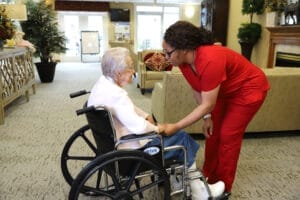According to the National Osteoporosis Foundation (NOF), approximately 9 million Americans currently have osteoporosis. Another 43 million have low bone density, which puts them at risk for the disease.
Osteoporosis is a disease that makes a person’s bones weak and more likely to break. People with osteoporosis or low bone density stand a greater chance of fracturing their bones, whether from a fall or even simply just bumping into furniture or sneezing.
May is National Osteoporosis Awareness and Prevention Month, which helps promote good bone health through the prevention, detection and treatment of osteoporosis. Throughout the month, people are encouraged to understand why they might be at risk for the disease, as well as what preventative measures can be taken for the promotion of healthy bones.
Raising Awareness of Osteoporosis
The first step in actually preventing osteoporosis is knowing if you possess the risk factors for getting the disease. Osteoporosis is known as a “silent disease” because you can’t actually feel your bones getting weaker. It’s likely that a person can have osteoporosis and not know it; they’ll only learn they do after they break a bone.
The factors that put you at risk for osteoporosis include:
- Your age. Older people are more likely than younger people to get osteoporosis, although it is possible to get it at any age.
- Your gender. Females make up 80 percent of the people who have osteoporosis. Men over the age of 50 are more likely to break a bone from osteoporosis than to get prostate cancer.
- Your body type. Being small and thin puts you more at risk for osteoporosis. However, this doesn’t mean larger body types won’t get it, too.
- Your lifestyle. You’re more at risk for osteoporosis if you live a sedentary lifestyle, smoke cigarettes and drink an excessive amount of alcohol. Exercising and eating healthy foods, as well as getting enough calcium and vitamin D can help prevent bone loss.
- Your family history. If your parents had osteoporosis, it’s more likely that you will have it, too. They may have gone undiagnosed, but if you know they suffered from broken bones or a curved spine, they probably had osteoporosis.
- Your medications and current health. Certain medicines like steroids that are used to treat asthma, allergies or arthritis can cause osteoporosis, as well as other medical conditions like celiac disease or diabetes. Talk to your doctor about your medications and health issues to see if you might be more at risk for osteoporosis.
Osteoporosis Prevention
The NOF recommends five steps for osteoporosis prevention and to improve your bone health:
- Get the correct daily amount of vitamin D and calcium. If necessary, take a calcium supplement. Talk to your doctor or pharmacist about the right amount of supplement you should take based on your current eating habits.
- Exercise regularly, focusing on weight-bearing and muscle-strengthening exercises. Your bones get stronger when you make them work!
- Avoid smoking and excessive alcohol use.
- Get a bone mineral density test if you are a woman who has reached menopause or a man age 50 or older, or at least talk to your doctor about when you should get one.
- Take the osteoporosis medication prescribed for you when the time comes to help prevent broken bones.
While there is no cure for osteoporosis at this time, a healthy lifestyle is key for osteoporosis prevention.
For more information about American Senior Communities, please visit https://www.asccare.com.



